Zinc Selenide (ZnSe) Windows

- Windows Designed for 600 nm - 16 µm
- Uncoated or AR-Coated Versions Available
- Ø1/2" and Ø1" Sizes Available
WG71050-E3
Ø1", AR-Coated for 7.0 - 12.0 µm
WG71050-E2
Ø1", AR-Coated for 4.5 - 7.5 µm
WG70530
Ø1/2", Uncoated
WG70530-D
Ø1/2", AR-Coated for 1.65 - 3.0 µm
WG70530-E4
Ø1/2", AR-Coated for 2.0 - 13.0 µm

Please Wait
| Flat Window Selection Guide | |
|---|---|
| Wavelength Range | Substrate Material |
| 180 nm - 8.0 μm | Calcium Fluoride (CaF2) |
| 185 nm - 2.1 μm | UV Fused Silica |
| 200 nm - 5.0 μm | Sapphire |
| 200 nm - 6.0 μm | Magnesium Fluoride (MgF2) |
| 220 nm to >50 µm | CVD Diamond Windows |
| 230 nm - 1.1 µm | UV Fused Silica, Textured Antireflective Surface |
| 250 nm - 1.6 µm | UV Fused Silica, for 45° AOI |
| 250 nm - 26 µm | Potassium Bromide (KBr) |
| 300 nm - 3 µm | Infrasil® |
| 350 nm - 2.0 μm | N-BK7 |
| 600 nm - 16 µm | Zinc Selenide (ZnSe) |
| 1 - 1.7 µm | Infrasil®, Textured Antireflective Surface |
| 1.2 - 8.0 μm | Silicon (Si) |
| 1.9 - 16 μm | Germanium (Ge) |
| 2 - 5 μm | Barium Fluoride (BaF2) |
| V-Coated Laser Windows | |
Features
- 1/2" and 1" Diameters Available
- Uncoated Windows for Visible and IR Applications in the 600 nm - 16 µm Spectral Range
- AR-Coated Options Available:
- -D Coating: 1.65 to 3.0 µm
- -E4 Coating: 2.0 to 13.0 µm
- -E2 Coating: 4.5 to 7.5 µm
- -E3 Coating: 7.0 to 12.0 µm
Thorlabs' Precision Zinc Selenide (ZnSe) Windows are offered in Ø1/2" and Ø1" sizes. They are available uncoated for use from 600 nm to 16 µm or with an antireflection (AR) coating on both sides from 1.65 to 3.0 µm, 2.0 to 13.0 µm, 4.5 to 7.5 µm, or 7.0 to 12.0 µm (see the Graphs tab for transmission and reflectance plots). Zinc selenide has a transmission band broader than silicon and germanium. Along with its low absorption in the red portion of the visible spectrum, zinc selenide is ideal for optical systems that combine a 10.6 µm CO2 laser with a 633 nm HeNe alignment laser.
This substrate scratches easily and should be handled with care. When handling optics, always wear gloves. This is especially true when working with zinc selenide, as it is a hazardous material. For your safety, please follow all proper precautions. For the MSDS for ZnSe in English, click here, and for the MSDS in Japanese, click here. Thorlabs will accept all ZnSe windows back for proper disposal. Please contact Tech Support to make arrangements for this service.
Thorlabs also offers precision windows fabricated from several other substrates for use in a large variety of laser and industrial applications. For our complete selection, see the Flat Window Selection Guide table to the right. We also offer laser windows, which have AR coatings centered around commonly used laser wavelengths, and Brewster windows, which are designed to eliminate P-polarized reflected light.
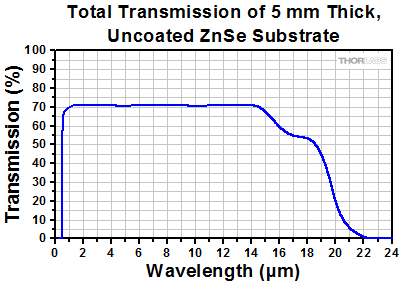
Click to Enlarge
Click for Raw Data
This graph shows the measured transmission of an uncoated zinc selenide window at normal incidence. Most of the transmission loss is due to surface reflections, rather than absorption, as demonstrated by the graphs for AR-coated windows below.

Click to Enlarge
Click for Raw Data
This graph shows the measured transmission of an AR-coated zinc selenide window at normal incidence. The shaded region denotes the AR coating range, over which Ravg < 1.0%. Performance outside of the specified range is not guaranteed and varies from lot to lot.
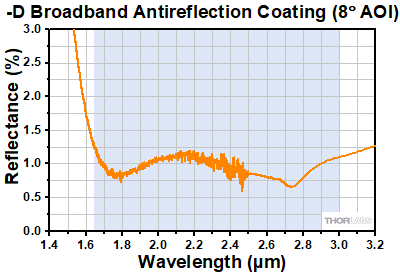
Click to Enlarge
Click for Raw Data
This plot gives the measured reflectance (per surface) at an 8° angle of incidence (AOI) of our -D AR-coated zinc selenide windows. The average reflectance is <1.0% per surface within the shaded wavelength range of 1.65 - 3 µm.
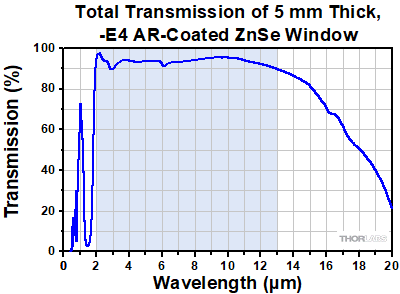
Click to Enlarge
Click for Raw Data
This graph shows the measured transmission of an AR-coated zinc selenide window at normal incidence. The shaded region denotes the AR coating range, over which Ravg < 3.5%. Performance outside of the specified range is not guaranteed and varies from lot to lot.
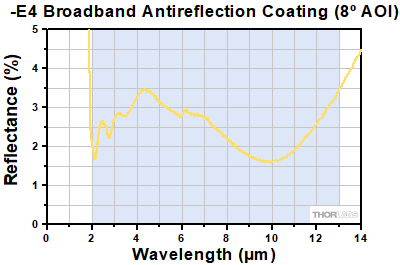
Click to Enlarge
Click for Raw Data
This plot gives the measured reflectance (per surface) at an 8° angle of incidence (AOI) of our -E4 AR-coated zinc selenide windows. The average reflectance is <3.5% per surface within the shaded wavelength range of 2.0 - 13.0 µm.
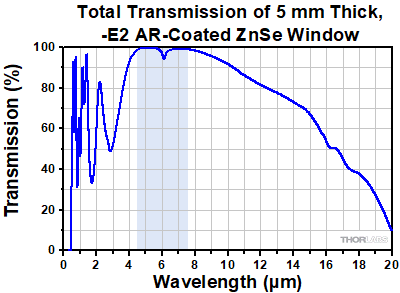
Click to Enlarge
Click for Raw Data
This graph shows the measured transmission of an AR-coated zinc selenide window at normal incidence. The shaded region denotes the AR coating range, over which Ravg < 1.0%. Performance outside of the specified range is not guaranteed and varies from lot to lot.
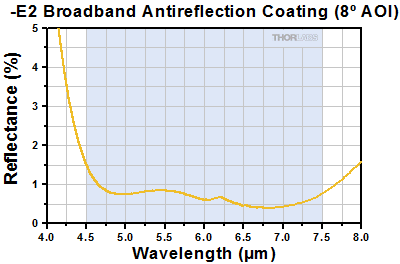
Click to Enlarge
Click for Raw Data
This plot gives the measured reflectance (per surface) at an 8° angle of incidence (AOI) of our -E2 AR-coated zinc selenide windows. The average reflectance is <1.0% per surface within the shaded wavelength range of 4.5 - 7.5 µm.

Click to Enlarge
Click for Raw Data
This graph shows the measured transmission of an -E3 AR-coated zinc selenide window at normal incidence. The shaded region denotes the AR coating range, over which Ravg < 1.0% and Rabs < 2.0%. Performance outside of the specified range is not guaranteed and varies from lot to lot.
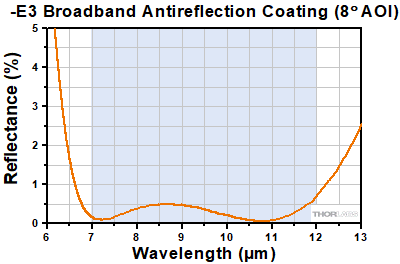
Click to Enlarge
Click for Raw Data
This plot gives the measured reflectance (per surface) at an 8° angle of incidence (AOI) of our -E3 AR-coated zinc selenide windows. The average reflectance is <1.0% and the absolute reflectance is <2.0% per surface within the shaded wavelength range of 7 - 12 µm.
| Damage Threshold Specifications | ||
|---|---|---|
| Item # | Damage Threshold | |
| WG70530-D WG71050-D |
Pulsed | 200 J/cm2 (2940 nm, 250 µs, 2 Hz, Ø99 µm) |
| WG70530-E3 WG71050-E3 |
CW | 1000 W/cm (10.6 µm, Ø138 µm) |
| Pulsed | 5 J/cm2 (10.6 µm, 100 ns, 1 Hz, Ø478 µm) | |
| WG70530-E4 WG71050-E4 |
CW | 1000 W/cm (10.6 µm, Ø138 µm) |
| Pulsed | 3 J/cm2 (10.6 µm, 100 ns, 1 Hz, Ø447 µm) | |
Damage Threshold Data for Thorlabs' ZnSe Windows
The specifications to the right are measured data for Thorlabs' ZnSe windows. Damage threshold specifications are constant for ZnSe windows with the same coating, regardless of the size of the window.
Laser Induced Damage Threshold Tutorial
The following is a general overview of how laser induced damage thresholds are measured and how the values may be utilized in determining the appropriateness of an optic for a given application. When choosing optics, it is important to understand the Laser Induced Damage Threshold (LIDT) of the optics being used. The LIDT for an optic greatly depends on the type of laser you are using. Continuous wave (CW) lasers typically cause damage from thermal effects (absorption either in the coating or in the substrate). Pulsed lasers, on the other hand, often strip electrons from the lattice structure of an optic before causing thermal damage. Note that the guideline presented here assumes room temperature operation and optics in new condition (i.e., within scratch-dig spec, surface free of contamination, etc.). Because dust or other particles on the surface of an optic can cause damage at lower thresholds, we recommend keeping surfaces clean and free of debris. For more information on cleaning optics, please see our Optics Cleaning tutorial.
Testing Method
Thorlabs' LIDT testing is done in compliance with ISO/DIS 11254 and ISO 21254 specifications.
First, a low-power/energy beam is directed to the optic under test. The optic is exposed in 10 locations to this laser beam for 30 seconds (CW) or for a number of pulses (pulse repetition frequency specified). After exposure, the optic is examined by a microscope (~100X magnification) for any visible damage. The number of locations that are damaged at a particular power/energy level is recorded. Next, the power/energy is either increased or decreased and the optic is exposed at 10 new locations. This process is repeated until damage is observed. The damage threshold is then assigned to be the highest power/energy that the optic can withstand without causing damage. A histogram such as that below represents the testing of one BB1-E02 mirror.

The photograph above is a protected aluminum-coated mirror after LIDT testing. In this particular test, it handled 0.43 J/cm2 (1064 nm, 10 ns pulse, 10 Hz, Ø1.000 mm) before damage.

| Example Test Data | |||
|---|---|---|---|
| Fluence | # of Tested Locations | Locations with Damage | Locations Without Damage |
| 1.50 J/cm2 | 10 | 0 | 10 |
| 1.75 J/cm2 | 10 | 0 | 10 |
| 2.00 J/cm2 | 10 | 0 | 10 |
| 2.25 J/cm2 | 10 | 1 | 9 |
| 3.00 J/cm2 | 10 | 1 | 9 |
| 5.00 J/cm2 | 10 | 9 | 1 |
According to the test, the damage threshold of the mirror was 2.00 J/cm2 (532 nm, 10 ns pulse, 10 Hz, Ø0.803 mm). Please keep in mind that these tests are performed on clean optics, as dirt and contamination can significantly lower the damage threshold of a component. While the test results are only representative of one coating run, Thorlabs specifies damage threshold values that account for coating variances.
Continuous Wave and Long-Pulse Lasers
When an optic is damaged by a continuous wave (CW) laser, it is usually due to the melting of the surface as a result of absorbing the laser's energy or damage to the optical coating (antireflection) [1]. Pulsed lasers with pulse lengths longer than 1 µs can be treated as CW lasers for LIDT discussions.
When pulse lengths are between 1 ns and 1 µs, laser-induced damage can occur either because of absorption or a dielectric breakdown (therefore, a user must check both CW and pulsed LIDT). Absorption is either due to an intrinsic property of the optic or due to surface irregularities; thus LIDT values are only valid for optics meeting or exceeding the surface quality specifications given by a manufacturer. While many optics can handle high power CW lasers, cemented (e.g., achromatic doublets) or highly absorptive (e.g., ND filters) optics tend to have lower CW damage thresholds. These lower thresholds are due to absorption or scattering in the cement or metal coating.

LIDT in linear power density vs. pulse length and spot size. For long pulses to CW, linear power density becomes a constant with spot size. This graph was obtained from [1].

Pulsed lasers with high pulse repetition frequencies (PRF) may behave similarly to CW beams. Unfortunately, this is highly dependent on factors such as absorption and thermal diffusivity, so there is no reliable method for determining when a high PRF laser will damage an optic due to thermal effects. For beams with a high PRF both the average and peak powers must be compared to the equivalent CW power. Additionally, for highly transparent materials, there is little to no drop in the LIDT with increasing PRF.
In order to use the specified CW damage threshold of an optic, it is necessary to know the following:
- Wavelength of your laser
- Beam diameter of your beam (1/e2)
- Approximate intensity profile of your beam (e.g., Gaussian)
- Linear power density of your beam (total power divided by 1/e2 beam diameter)
Thorlabs expresses LIDT for CW lasers as a linear power density measured in W/cm. In this regime, the LIDT given as a linear power density can be applied to any beam diameter; one does not need to compute an adjusted LIDT to adjust for changes in spot size, as demonstrated by the graph to the right. Average linear power density can be calculated using the equation below.

The calculation above assumes a uniform beam intensity profile. You must now consider hotspots in the beam or other non-uniform intensity profiles and roughly calculate a maximum power density. For reference, a Gaussian beam typically has a maximum power density that is twice that of the uniform beam (see lower right).
Now compare the maximum power density to that which is specified as the LIDT for the optic. If the optic was tested at a wavelength other than your operating wavelength, the damage threshold must be scaled appropriately. A good rule of thumb is that the damage threshold has a linear relationship with wavelength such that as you move to shorter wavelengths, the damage threshold decreases (i.e., a LIDT of 10 W/cm at 1310 nm scales to 5 W/cm at 655 nm):

While this rule of thumb provides a general trend, it is not a quantitative analysis of LIDT vs wavelength. In CW applications, for instance, damage scales more strongly with absorption in the coating and substrate, which does not necessarily scale well with wavelength. While the above procedure provides a good rule of thumb for LIDT values, please contact Tech Support if your wavelength is different from the specified LIDT wavelength. If your power density is less than the adjusted LIDT of the optic, then the optic should work for your application.
Please note that we have a buffer built in between the specified damage thresholds online and the tests which we have done, which accommodates variation between batches. Upon request, we can provide individual test information and a testing certificate. The damage analysis will be carried out on a similar optic (customer's optic will not be damaged). Testing may result in additional costs or lead times. Contact Tech Support for more information.
Pulsed Lasers
As previously stated, pulsed lasers typically induce a different type of damage to the optic than CW lasers. Pulsed lasers often do not heat the optic enough to damage it; instead, pulsed lasers produce strong electric fields capable of inducing dielectric breakdown in the material. Unfortunately, it can be very difficult to compare the LIDT specification of an optic to your laser. There are multiple regimes in which a pulsed laser can damage an optic and this is based on the laser's pulse length. The highlighted columns in the table below outline the relevant pulse lengths for our specified LIDT values.
Pulses shorter than 10-9 s cannot be compared to our specified LIDT values with much reliability. In this ultra-short-pulse regime various mechanics, such as multiphoton-avalanche ionization, take over as the predominate damage mechanism [2]. In contrast, pulses between 10-7 s and 10-4 s may cause damage to an optic either because of dielectric breakdown or thermal effects. This means that both CW and pulsed damage thresholds must be compared to the laser beam to determine whether the optic is suitable for your application.
| Pulse Duration | t < 10-9 s | 10-9 < t < 10-7 s | 10-7 < t < 10-4 s | t > 10-4 s |
|---|---|---|---|---|
| Damage Mechanism | Avalanche Ionization | Dielectric Breakdown | Dielectric Breakdown or Thermal | Thermal |
| Relevant Damage Specification | No Comparison (See Above) | Pulsed | Pulsed and CW | CW |
When comparing an LIDT specified for a pulsed laser to your laser, it is essential to know the following:

LIDT in energy density vs. pulse length and spot size. For short pulses, energy density becomes a constant with spot size. This graph was obtained from [1].
- Wavelength of your laser
- Energy density of your beam (total energy divided by 1/e2 area)
- Pulse length of your laser
- Pulse repetition frequency (prf) of your laser
- Beam diameter of your laser (1/e2 )
- Approximate intensity profile of your beam (e.g., Gaussian)
The energy density of your beam should be calculated in terms of J/cm2. The graph to the right shows why expressing the LIDT as an energy density provides the best metric for short pulse sources. In this regime, the LIDT given as an energy density can be applied to any beam diameter; one does not need to compute an adjusted LIDT to adjust for changes in spot size. This calculation assumes a uniform beam intensity profile. You must now adjust this energy density to account for hotspots or other nonuniform intensity profiles and roughly calculate a maximum energy density. For reference a Gaussian beam typically has a maximum energy density that is twice that of the 1/e2 beam.
Now compare the maximum energy density to that which is specified as the LIDT for the optic. If the optic was tested at a wavelength other than your operating wavelength, the damage threshold must be scaled appropriately [3]. A good rule of thumb is that the damage threshold has an inverse square root relationship with wavelength such that as you move to shorter wavelengths, the damage threshold decreases (i.e., a LIDT of 1 J/cm2 at 1064 nm scales to 0.7 J/cm2 at 532 nm):

You now have a wavelength-adjusted energy density, which you will use in the following step.
Beam diameter is also important to know when comparing damage thresholds. While the LIDT, when expressed in units of J/cm², scales independently of spot size; large beam sizes are more likely to illuminate a larger number of defects which can lead to greater variances in the LIDT [4]. For data presented here, a <1 mm beam size was used to measure the LIDT. For beams sizes greater than 5 mm, the LIDT (J/cm2) will not scale independently of beam diameter due to the larger size beam exposing more defects.
The pulse length must now be compensated for. The longer the pulse duration, the more energy the optic can handle. For pulse widths between 1 - 100 ns, an approximation is as follows:

Use this formula to calculate the Adjusted LIDT for an optic based on your pulse length. If your maximum energy density is less than this adjusted LIDT maximum energy density, then the optic should be suitable for your application. Keep in mind that this calculation is only used for pulses between 10-9 s and 10-7 s. For pulses between 10-7 s and 10-4 s, the CW LIDT must also be checked before deeming the optic appropriate for your application.
Please note that we have a buffer built in between the specified damage thresholds online and the tests which we have done, which accommodates variation between batches. Upon request, we can provide individual test information and a testing certificate. Contact Tech Support for more information.
[1] R. M. Wood, Optics and Laser Tech. 29, 517 (1998).
[2] Roger M. Wood, Laser-Induced Damage of Optical Materials (Institute of Physics Publishing, Philadelphia, PA, 2003).
[3] C. W. Carr et al., Phys. Rev. Lett. 91, 127402 (2003).
[4] N. Bloembergen, Appl. Opt. 12, 661 (1973).
In order to illustrate the process of determining whether a given laser system will damage an optic, a number of example calculations of laser induced damage threshold are given below. For assistance with performing similar calculations, we provide a spreadsheet calculator that can be downloaded by clicking the button to the right. To use the calculator, enter the specified LIDT value of the optic under consideration and the relevant parameters of your laser system in the green boxes. The spreadsheet will then calculate a linear power density for CW and pulsed systems, as well as an energy density value for pulsed systems. These values are used to calculate adjusted, scaled LIDT values for the optics based on accepted scaling laws. This calculator assumes a Gaussian beam profile, so a correction factor must be introduced for other beam shapes (uniform, etc.). The LIDT scaling laws are determined from empirical relationships; their accuracy is not guaranteed. Remember that absorption by optics or coatings can significantly reduce LIDT in some spectral regions. These LIDT values are not valid for ultrashort pulses less than one nanosecond in duration.

A Gaussian beam profile has about twice the maximum intensity of a uniform beam profile.
CW Laser Example
Suppose that a CW laser system at 1319 nm produces a 0.5 W Gaussian beam that has a 1/e2 diameter of 10 mm. A naive calculation of the average linear power density of this beam would yield a value of 0.5 W/cm, given by the total power divided by the beam diameter:

However, the maximum power density of a Gaussian beam is about twice the maximum power density of a uniform beam, as shown in the graph to the right. Therefore, a more accurate determination of the maximum linear power density of the system is 1 W/cm.
An AC127-030-C achromatic doublet lens has a specified CW LIDT of 350 W/cm, as tested at 1550 nm. CW damage threshold values typically scale directly with the wavelength of the laser source, so this yields an adjusted LIDT value:

The adjusted LIDT value of 350 W/cm x (1319 nm / 1550 nm) = 298 W/cm is significantly higher than the calculated maximum linear power density of the laser system, so it would be safe to use this doublet lens for this application.
Pulsed Nanosecond Laser Example: Scaling for Different Pulse Durations
Suppose that a pulsed Nd:YAG laser system is frequency tripled to produce a 10 Hz output, consisting of 2 ns output pulses at 355 nm, each with 1 J of energy, in a Gaussian beam with a 1.9 cm beam diameter (1/e2). The average energy density of each pulse is found by dividing the pulse energy by the beam area:

As described above, the maximum energy density of a Gaussian beam is about twice the average energy density. So, the maximum energy density of this beam is ~0.7 J/cm2.
The energy density of the beam can be compared to the LIDT values of 1 J/cm2 and 3.5 J/cm2 for a BB1-E01 broadband dielectric mirror and an NB1-K08 Nd:YAG laser line mirror, respectively. Both of these LIDT values, while measured at 355 nm, were determined with a 10 ns pulsed laser at 10 Hz. Therefore, an adjustment must be applied for the shorter pulse duration of the system under consideration. As described on the previous tab, LIDT values in the nanosecond pulse regime scale with the square root of the laser pulse duration:

This adjustment factor results in LIDT values of 0.45 J/cm2 for the BB1-E01 broadband mirror and 1.6 J/cm2 for the Nd:YAG laser line mirror, which are to be compared with the 0.7 J/cm2 maximum energy density of the beam. While the broadband mirror would likely be damaged by the laser, the more specialized laser line mirror is appropriate for use with this system.
Pulsed Nanosecond Laser Example: Scaling for Different Wavelengths
Suppose that a pulsed laser system emits 10 ns pulses at 2.5 Hz, each with 100 mJ of energy at 1064 nm in a 16 mm diameter beam (1/e2) that must be attenuated with a neutral density filter. For a Gaussian output, these specifications result in a maximum energy density of 0.1 J/cm2. The damage threshold of an NDUV10A Ø25 mm, OD 1.0, reflective neutral density filter is 0.05 J/cm2 for 10 ns pulses at 355 nm, while the damage threshold of the similar NE10A absorptive filter is 10 J/cm2 for 10 ns pulses at 532 nm. As described on the previous tab, the LIDT value of an optic scales with the square root of the wavelength in the nanosecond pulse regime:

This scaling gives adjusted LIDT values of 0.08 J/cm2 for the reflective filter and 14 J/cm2 for the absorptive filter. In this case, the absorptive filter is the best choice in order to avoid optical damage.
Pulsed Microsecond Laser Example
Consider a laser system that produces 1 µs pulses, each containing 150 µJ of energy at a repetition rate of 50 kHz, resulting in a relatively high duty cycle of 5%. This system falls somewhere between the regimes of CW and pulsed laser induced damage, and could potentially damage an optic by mechanisms associated with either regime. As a result, both CW and pulsed LIDT values must be compared to the properties of the laser system to ensure safe operation.
If this relatively long-pulse laser emits a Gaussian 12.7 mm diameter beam (1/e2) at 980 nm, then the resulting output has a linear power density of 5.9 W/cm and an energy density of 1.2 x 10-4 J/cm2 per pulse. This can be compared to the LIDT values for a WPQ10E-980 polymer zero-order quarter-wave plate, which are 5 W/cm for CW radiation at 810 nm and 5 J/cm2 for a 10 ns pulse at 810 nm. As before, the CW LIDT of the optic scales linearly with the laser wavelength, resulting in an adjusted CW value of 6 W/cm at 980 nm. On the other hand, the pulsed LIDT scales with the square root of the laser wavelength and the square root of the pulse duration, resulting in an adjusted value of 55 J/cm2 for a 1 µs pulse at 980 nm. The pulsed LIDT of the optic is significantly greater than the energy density of the laser pulse, so individual pulses will not damage the wave plate. However, the large average linear power density of the laser system may cause thermal damage to the optic, much like a high-power CW beam.
| Posted Comments: | |
Michele Cotrufo
(posted 2022-11-13 10:16:37.723) What is the E3 AR coating made of? Would it survive if I clean the window with acetone/IPA ? cdolbashian
(posted 2022-11-16 03:27:04.0) Thank you for reaching out to us. Unfortunately we cannot share the material used, as the recipe is proprietary. That being said, it will survive these types of chemicals. Please feel free follow this guide if you are unsure! https://www.thorlabs.com/newgrouppage9.cfm?objectgroup_id=9025. Michele Cotrufo
(posted 2022-11-12 08:58:38.943) Can you provide 1/2-inch windows with the E3 coating only on one side? cdolbashian
(posted 2022-11-16 03:27:06.0) Thank you for reaching out to us with this inquiry. Depending on the quantity, this is something we can do. I have reached out to you to discuss the possibility of a custom. For future custom requests please feel free to email our Solutions Team at techsales@thorlabs.com. Ilya Radko
(posted 2020-12-07 11:28:11.323) Are you able to make E4 coating for a 2" window? Or at least to sell a 2" window without any coating? It seems you have facility for 2" ZnSe optics (e.g., model BSW720). YLohia
(posted 2020-12-08 11:21:22.0) Thank you for contacting Thorlabs. Custom optics can be requested by clicking on the "Request Quote" button above or by emailing your local Thorlabs Tech Support Team (in your case techsupport.se@thorlabs.com). We will reach out to you directly to discuss the possibility of offering this customization. Anne Müller
(posted 2020-08-06 06:24:46.59) Hallo, liebes Thorlabs-Team, wäre es möglich, dieses Fenster auch nur mit einer einseitigen AR Beschichtung zu bekommen? Wenn ja, was kostet es?
Dankeschön
Anne-D. Müller nbayconich
(posted 2020-08-07 09:37:04.0) Thank you for contacting Thorlabs. A techsupport representative will contact you directly to discuss our custom capabilities. kkmion
(posted 2018-08-04 08:16:29.44) Do you have E4 coating for 1" window? YLohia
(posted 2018-08-06 04:50:54.0) Hello, thank you for contacting Thorlabs. The 1" version of the E4 coated window is due to be released soon as a stock item under the part number WG71050-E4. hasal
(posted 2017-11-13 07:41:58.173) Is there any kind of reactivity of material in presence of slightly acidic environment? ph 4-7 nbayconich
(posted 2017-12-19 01:55:31.0) Thank you for contacting Thorlabs. Our zinc selenide substrates are not intended to be used in any type of immersion. Zinc selenide can react with oxidizing agents such as mineral acids which can result in Hydrogen Selenide gas. Please refer to our material safety data sheet located in the link below. I will reach out to you directly about your application.
https://www.thorlabs.com/images/tabimages/Zinc-Selenide_MSDS.pdf patrick.o'rourke
(posted 2017-09-18 08:56:23.703) Can you provide an AR coating for 8 micron wavelength that can be used at 45 degree AOI? nbayconich
(posted 2017-09-29 04:30:13.0) Thank you for contacting Thorlabs. I will contact you directly about our custom capabilities. patrick.e.o'rourke
(posted 2016-02-25 13:48:07.413) Could you provide this window coated on one side only? I want to use it as IR beam splitter.
Contact: patrick.e.o'rourke@srnl.doe.gov jlow
(posted 2016-02-29 11:51:30.0) Response from Jeremy at Thorlabs: Yes we can quote this. We will contact you directly about the quote. erika.robert.001
(posted 2013-02-25 05:34:45.877) Hello,
I have several questions on your 1mm uncoated ZnSe transmittance spectrum: is this measured on a single crystal? Does it then depend on a specific crytallographic direction?
I am looking for a proper spectrum for a 100nm layer ZnSe and was trying to extract it from your spectrum. Are you aware that the absorption coefficient you have is really different from the one obtained by Adachi and Taguchi in their paper "Optical Properties of ZnSe", Physical Review B, Volume 43, Number 12?
Could you explain this?
Would you then have any idea for the behaviour of the absorption coefficient for a polycrystal?
That would be really nice from you if you could provide me these informations.
Thank you really much in advance. tcohen
(posted 2013-03-06 14:41:00.0) Response from Tim at Thorlabs: Thank you for contacting us. Adachi and Taguchi’s paper explores the absorption coefficient down to 3eV, which would correspond to ~413nm. Their data suggests an absorption coefficient of 10^5 cm^-1. The relative transmission through a 1mm sample based on their results is far below the noise of the spectrophotometer used to take this data and agrees with our note that transmission is effectively 0% at these wavelengths. I will contact you to continue this discussion. jlow
(posted 2012-11-08 10:09:00.0) Response from Jeremy at Thorlabs: We will post the transmission data we have for the visible range on website. user
(posted 2012-11-08 08:24:10.67) Can you extend your transmission plots down to 200 nm, need to understand how much visible light will leak through my system. jlow
(posted 2012-10-02 11:07:00.0) Response from Jeremy at Thorlabs: None of our optics that would be a high reflector at 10.6µm (i.e. metallic mirrors, -M01, -P01, -G01) would transmit red light. The same is true for the reverse. None of our red reflectors would transmit 10.6µm light at anything close to 100%. With this in mind, we will look into the feasibility of adding this to our product line in the future. paul.taylor
(posted 2012-09-27 09:28:41.0) Can you recommend an optic for combining a 10600 nm CO2 laser beam and a red diode laser tracer. I guess the red tracer wouldn't have to be high reflection (>10%)- but the 10600 nm needs to be near to 100%
Thanks tttang
(posted 2011-09-20 12:40:02.0) Is this window coated on both sides? Could we use this one as a beam combiner for 8um? Thank you very much. |
| Window Selection Guide (Table Sorted by Wavelength) | |||||
|---|---|---|---|---|---|
| Substrate and Window Type | Wavelength Range | Available AR Coatings | Reflectance over AR Coating Rangea | Transmission Data | Reflectance Data |
| Calcium Fluoride (CaF2): Flat or Wedged |
180 nm - 8.0 μm | Uncoated | - | Raw Data |
- |
| -D Coating, 1.65 - 3.0 µm | Ravg < 1.0%; Rabs < 2.0% at 0° AOI | Raw Data |
Raw Data |
||
| UV Fused Silica: Flat, Wedged, V-Coated Flat, or V-Coated Wedged |
185 nm - 2.1 μm | Uncoated (Flat or Wedged) |
- | Raw Data |
- |
| -UV Coating, 245 - 400 nm (Flat or Wedged) |
Ravg < 0.5% at 0° AOI | - | Raw Data |
||
| -C3 Coating, 261 - 266 nm (V-Coated) |
Ravg < 0.5% at 0° AOI | - | Raw Data |
||
| -C6 Coating, 350 - 450 nm (V-Coated) |
Ravg < 0.5% at 0° AOI | - | Raw Data |
||
| -A Coating, 350 - 700 nm (Flat or Wedged) |
Ravg < 0.5% at 0° AOI | - | Raw Data |
||
| -B Coating, 650 - 1050 nm (Flat or Wedged) |
Ravg < 0.5% at 0° AOI | - | Raw Data |
||
| -C Coating, 1050 - 1700 nm (Flat or Wedged) |
Ravg < 0.5% at 0° AOI | - | Raw Data |
||
| Sapphire: Flat or Wedged |
200 nm - 5.0 μm | Uncoated | - | Raw Data |
- |
| -D Coating, 1.65 - 3.0 µm | Ravg < 1.0% at 0° AOI | Raw Data |
Raw Data |
||
| -E1 Coating, 2.0 - 5.0 µm | Ravg < 1.50%, Rabs < 3.0% (per Surface, 2.0 - 5.0 µm); Ravg < 1.75% (per Surface, 2.0 - 4.0 µm) at 0° AOI |
Raw Data |
Raw Data |
||
| Magnesium Fluoride (MgF2): Flat or Wedged |
200 nm - 6.0 μm | Uncoated | - | Raw Data |
- |
| Barium Fluoride (BaF2): Flat or Wedged |
200 nm - 11 µm | Uncoated (Wedged Only) |
- | Raw Data |
- |
| -E1 Coating, 2 - 5 µm | Ravg < 1.25%; Rabs < 2.5% at 0° AOI | Raw Data |
Raw Data |
||
| UV Fused Silica, for 45° AOI: Flat or Wedged |
250 nm - 1.6 µm | Coating for 250 nm - 450 nm |
Ravg < 1.0% at 45° AOI | Raw Data |
|
| Coating for 350 nm - 1100 nm |
Ravg < 2.0% at 45° AOI | Raw Data |
|||
| Coating for 400 nm - 700 nm |
Ravg < 1.0% at 45° AOI | Raw Data |
|||
| Coating for 600 nm - 1700 nm |
Ravg < 1.5% at 45° AOI | Raw Data |
|||
| Coating for 700 nm - 1100 nm |
Ravg < 1.0% at 45° AOI | Raw Data |
|||
| Coating for 1200 nm - 1600 nm |
Ravg < 1.0% at 45° AOI | Raw Data |
|||
| Potassium Bromide (KBr): Flat |
250 nm - 26 µm | Uncoated | - | - | |
| Infrasil®: Flat |
300 nm - 3 µm | Uncoated | - | Raw Data |
- |
| N-BK7: Flat, Wedged, V-Coated Flat, or V-Coated Wedged |
350 nm - 2.0 μm | Uncoated (Flat or Wedged) |
- | Raw Data |
- |
| -A Coating, 350 - 700 nm (Flat or Wedged) |
Ravg < 0.5% at 0° AOI | - | Raw Data |
||
| -C7 Coating, 400 - 700 nm (V-Coated) |
Ravg < 0.5% at 0° AOI | - | Raw Data |
||
| -C10 Coating, 523 - 532 nm (V-Coated) |
Ravg < 0.5% at 0° AOI | - | Raw Data |
||
| -C11 Coating, 610 - 860 nm (V-Coated) |
Ravg < 0.5% at 0° AOI | - | Raw Data |
||
| -B Coating, 650 - 1050 nm (Flat or Wedged) |
Ravg < 0.5% at 0° AOI | - | Raw Data |
||
| -C13 Coating, 700 - 1100 nm (V-Coated) |
Ravg < 0.5% at 0° AOI | - | Raw Data |
||
| C14 Coating, 1047 - 1064 nm (V-Coated) |
Ravg < 0.5% at 0° AOI | - | Raw Data |
||
| -C15 Coating, 523 - 532 nm & 1047 - 1064 nm (V-Coated) |
Ravg < 0.5% at 0° AOI | - | Raw Data |
||
| -C Coating, 1050 - 1700 nm (Flat or Wedged) |
Ravg < 0.5% at 0° AOI | - | Raw Data |
||
| Zinc Selenide (ZnSe): Flat or Wedged |
600 nm - 16 µm | Uncoated | - | Raw Data |
- |
| -D Coating, 1.65 - 3.0 µm | Ravg < 1.0%; Rabs < 2.0% at 0° AOI | Raw Data |
Raw Data |
||
| -E4 Coating, 2 - 13 µm (Only Flat) |
Ravg < 3.5%; Rabs < 6% at 0° AOI | Raw Data |
Raw Data |
||
| -E2 Coating, 4.5 - 7.5 µm (Only Flat) |
Ravg < 1.0%; Rabs < 2.0% at 0° AOI | Raw Data |
Raw Data |
||
| -E3 Coating, 7 - 12 µm (Only Wedged) |
Ravg < 1.0%; Rabs < 2.0% at 0° AOI | Raw Data |
Raw Data |
||
| -G Coating, 7 - 12 µm (Only Flat) |
Ravg < 1% at 0° AOI | Raw Data |
Raw Data |
||
| Silicon (Si): Flat or Wedged |
1.2 - 8.0 μm | Uncoated | - | Raw Data |
- |
| -E1 Coating, 2 - 5 µm (Only Wedged) |
Ravg < 1.25%; Rabs < 2.5% at 0° AOI | Raw Data |
Raw Data |
||
| -E Coating, 3 - 5 µm (Only Flat) |
Ravg < 2% at 0° AOI | Raw Data |
Raw Data |
||
| Germanium (Ge): Flat or Wedged |
1.9 - 16 μm | Uncoated, 2.0 - 16 μm | - | Raw Data |
- |
| -C9 Coating, 1.9 - 6 µm (Only Flat) |
Ravg < 2% at 0° AOI | Raw Data |
Raw Data |
||
| -E3 Coating, 7 - 12 µm | Ravg < 1.0%; Rabs < 2.0% at 0° AOI | Raw Data |
Raw Data |
||

| Item # | WG70530-D | WG71050-D | ||
|---|---|---|---|---|
| Diameter | 1/2" (12.7 mm) | 1" (25.4 mm) | ||
| Diameter Tolerance | +0.0 / -0.2 mm | |||
| Thickness | 3.0 mm | 5.0 mm | ||
| Thickness Tolerance | ±0.3 mm | |||
| Clear Aperture | >Ø11.4 mm | >Ø22.9 mm | ||
| Parallelism | <1 arcmin | |||
| Transmitted Wavefront Errora | ≤3λ/2 Over Central 5 mm ≤3λ Over Full Clear Aperture |
≤3λ/2 Over Central 10 mm ≤3λ Over Full Clear Aperture |
||
| Surface Quality | 40-20 Scratch-Dig | |||
| AR Coating Range | 1.65 - 3.0 µm (-D Coating) | |||
| AR Coating Reflectanceb | Ravg < 1.0%c; Rabs < 2.0% (0° AOI) | |||
| Reflectance Data | Raw Data |
|||
| Transmissiond | Tavg > 94.0%c; Tabs > 90% (0° AOI) | |||
| Transmission Data | Raw Data |
|||
| Substrate | Zinc Selenidee | |||
| Damage Threshold | Pulsed | 200 J/cm2 (2940 nm, 250 µs, 2 Hz, Ø0.099 mm) | ||

| Item # | WG70530-E4 | WG71050-E4 | |
|---|---|---|---|
| Diameter | 1/2" (12.7 mm) | 1" (25.4 mm) | |
| Diameter Tolerance | +0.0 / -0.2 mm | ||
| Thickness | 3.0 mm | 5.0 mm | |
| Thickness Tolerance | ±0.1 mm | ||
| Clear Aperture | >Ø11.4 mm | >Ø22.9 mm | |
| Parallelism | <1 arcmin | ||
| Transmitted Wavefront Errora | <λ/2 Over Clear Aperture | <2λ Over Clear Aperture | |
| Surface Quality | 40-20 Scratch-Dig | ||
| AR Coating Range | 2.0 - 13.0 µm (-E4 Coating) | ||
| AR Coating Reflectanceb | Ravg < 3.5%c, Rabs < 6% (0° AOI) | ||
| Reflectance Data | Raw Data |
||
| Transmissiond | Tavg > 92%c; Tabs > 85% (0° AOI) | ||
| Transmission Data | Raw Data |
||
| Substrate | Zinc Selenidee | ||
| Damage Threshold | CW | 1000 W/cm (10.6 µm, Ø138 µm) | |
| Pulsed | 3 J/cm2 (10.6 µm, 100 ns, 1 Hz, Ø447 µm) | ||

| Item # | WG70530-E2 | WG71050-E2 | |
|---|---|---|---|
| Diameter | 1/2" (12.7 mm) | 1" (25.4 mm) | |
| Diameter Tolerance | +0.0 / -0.2 mm | ||
| Thickness | 3.0 mm | 5.0 mm | |
| Thickness Tolerance | ±0.1 mm | ||
| Clear Aperture | >Ø11.4 mm | >Ø22.9 mm | |
| Parallelism | ≤1 arcmin | ||
| Transmitted Wavefront Errora | <3λ/2 Over Central 5.0 mm <3λ Over Full Clear Aperture |
<3λ/2 Over Central 10.0 mm <3λ Over Full Clear Aperture |
|
| Surface Quality | 40-20 Scratch-Dig | ||
| AR Coating Range | 4.5 - 7.5 µm (-E2 Coating) | ||
| AR Coating Reflectanceb | Ravg < 1.0%c; Rabs < 2.0% (0° AOI) | ||
| Reflectance Data | Raw Data |
||
| Transmissiond | Tavg > 97%c; Tabs > 94% (0° AOI) | ||
| Transmission Data | Raw Data |
||
| Substrate | Zinc Selenidee | ||
| Damage Threshold | - | ||

| Item # | WG70530-E3 | WG71050-E3 | ||
|---|---|---|---|---|
| Diameter | 1/2" (12.7 mm) | 1" (25.4 mm) | ||
| Diameter Tolerance | +0.0 / -0.2 mm | |||
| Thickness | 3.0 mm | 5.0 mm | ||
| Thickness Tolerance | ±0.1 mm | ±0.3 mm | ||
| Clear Aperture | >Ø11.4 mm | >Ø22.9 mm | ||
| Parallelism | <1 arcmin | |||
| Surface Flatnessa | <λ/2 Over Clear Aperture | <λ Over Clear Aperture | ||
| Surface Quality | 40-20 Scratch-Dig | |||
| AR Coating Range | 7.0 - 12.0 µm (-E3 Coating) | |||
| AR Coating Reflectanceb | Ravg < 1.0%c; Rabs < 2.0% (0° AOI) | |||
| Reflectance Data | Raw Data |
|||
| Transmissiond | Tavg > 97%c; Tabs > 92% (0° AOI) | |||
| Transmission Data | Raw Data |
|||
| Substrate | Zinc Selenidee | |||
| Damage Threshold | CW | 1000 W/cm (10.6 µm, Ø138 µm) | ||
| Pulsed | 5 J/cm2 (10.6 µm, 100 ns, 1 Hz, Ø478 µm) | |||
 Products Home
Products Home











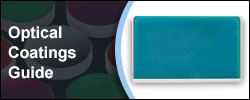


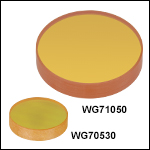
 Zoom
Zoom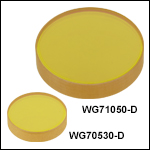

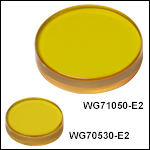

 Zinc Selenide Windows,
Zinc Selenide Windows,